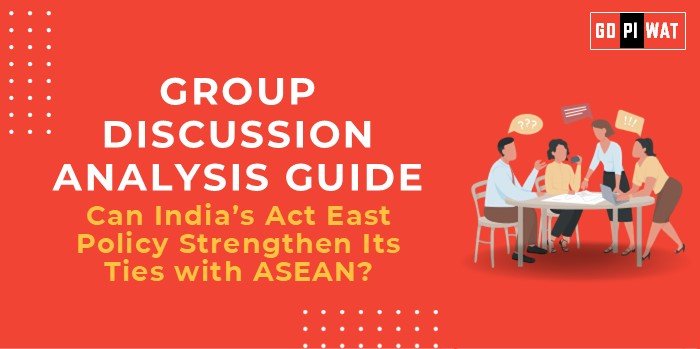📋 Group Discussion (GD) Analysis Guide
🌏 Can India’s Act East Policy Strengthen Its Ties with ASEAN?
🌟 Introduction
• Opening Context: “India’s Act East Policy, launched in 2014, extends beyond economic cooperation to include strategic and cultural ties with ASEAN, strengthening India’s Indo-Pacific vision.”
• Background: Building upon the Look East Policy (1991), the Act East Policy aims for enhanced engagement with ASEAN in trade, connectivity, and security.
📊 Quick Facts & Key Statistics
- 💼 ASEAN-India Trade (2023): $131.5 billion, representing 11.3% of India’s global trade.
- 📈 India’s Investments in ASEAN (2019-2022): $55.5 billion, with over $51 billion invested in Singapore.
- 🌏 ASEAN Population (2022): 662 million people, offering a vast market for Indian industries.
- 🚢 Maritime Trade Routes: The Strait of Malacca facilitates 40% of India’s trade, underscoring ASEAN’s strategic importance.
🤝 Stakeholders and Their Roles
- 🏛️ Government of India: Spearheads policies like Act East and invests in infrastructure projects like the Trilateral Highway.
- 🌐 ASEAN Member States: Collaborate on trade, cultural exchanges, and defense initiatives.
- 💼 Private Sector: Invests in sectors like technology, manufacturing, and renewable energy.
- 👥 Civil Society: Promotes cultural exchanges and people-to-people connectivity.
- 🌍 Global Players: Influence the region through competing strategic and economic agendas, such as China’s Belt and Road Initiative (BRI).
📈 Achievements and Challenges
🏆 Achievements:
- ✔️ Enhanced Economic Engagement: Trade with ASEAN rose to $131.5 billion in FY 2022-23.
- ⚔️ Strategic Partnerships: Conducting joint military exercises like SIMBEX and MILAN.
- 🚧 Connectivity Projects: Trilateral Highway and Kaladan Multimodal Transit boost regional integration.
⚠️ Challenges:
- 📉 Infrastructure Delays: Projects like the Trilateral Highway face prolonged timelines.
- ⚖️ Trade Imbalance: ASEAN countries export more to India than they import.
- 🌍 Geopolitical Tensions: China’s dominance through BRI challenges India’s influence.
🗣️ Effective Discussion Approaches
💬 Opening Approaches:
- 📊 Highlight ASEAN-India trade milestones to emphasize economic importance.
- 🚢 Use maritime trade statistics to underscore strategic connectivity.
- 🌍 Mention China’s influence to introduce competitive challenges.
🤔 Counter-Argument Handling:
- 💡 Present solutions like diversifying investments across ASEAN nations.
- 📢 Highlight India’s progress in connectivity and strategic defense.
📌 Strategic Analysis of Strengths & Weaknesses
✅ Strengths:
- ✔️ Robust trade relations.
- 🚢 Strategic maritime routes.
- 🌏 Cultural ties.
❌ Weaknesses:
- 📉 Delayed infrastructure projects.
- ⚖️ Uneven investments.
- ⚠️ Trade imbalances.
🌟 Opportunities:
- 🌱 Renewable energy collaborations.
- 💻 Digital economy partnerships.
⚠️ Threats:
- 🌏 ASEAN’s growing reliance on China.
- 🚫 Regional geopolitical rivalries.
📚 Structured Arguments for Discussion
- 🟢 Supporting Stance: “India’s Act East Policy leverages strategic trade and defense partnerships to benefit both India and ASEAN.”
- 🔴 Opposing Stance: “China’s deep economic ties with ASEAN overshadow India’s Act East Policy ambitions.”
- ⚖️ Balanced Perspective: “While India has made progress, addressing infrastructure and trade challenges can maximize ASEAN collaboration.”
🎓 Connecting with B-School Applications
📖 Real-World Applications:
- 🌐 Study Act East Policy’s implications for international business strategy.
❓ Sample Interview Questions:
- 💬 “How does India’s Act East Policy align with its Indo-Pacific objectives?”
- 🖥️ “What role can India play in ASEAN’s digital transformation?”
💡 Insights for Students:
- 📘 Explore the balance between economic policies and geopolitical strategy in business.


